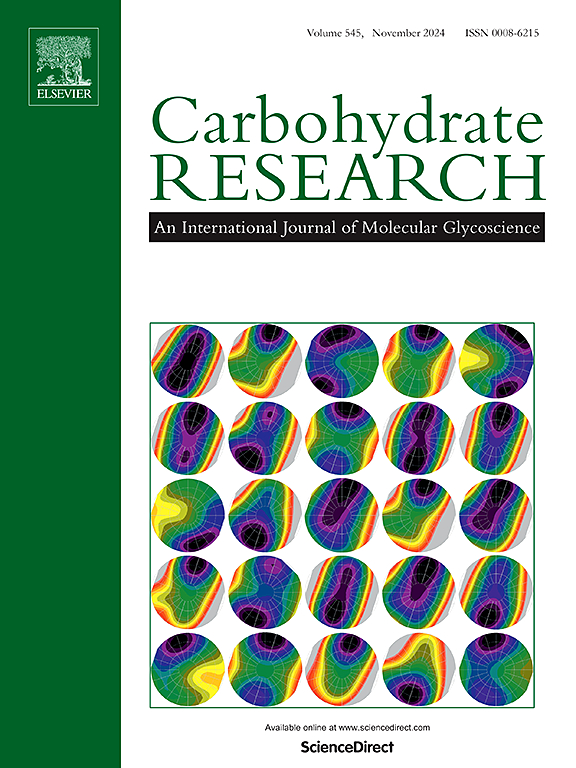Efficient synthesis of coumarin based triazole linked O-glycoconjugates as new bio-active glycohybrids
IF 2.4
3区 化学
Q3 BIOCHEMISTRY & MOLECULAR BIOLOGY
引用次数: 0
Abstract
Glycohybrids are biologically significant molecules with variety of biological functions and are found as structural motifs in numerous natural products. Here, we report the synthesis of various new coumarin-based O-glycoconjugates as glycohybrids that are chirally enriched and bridged by 1,2,3-triazoles ring system. The1,2,3-triazoles bridging was done via CuAAC click-chemistry. Click chemistry offers several advantages, including high chemo- and regioselectivity, mild reaction conditions, easy purification, and compatibility with multiple functional groups. Two series of O-glycoconjugates as new glycohybrids were designed and efficiently synthesized in very good isolated yields, using d-glucose, d-galactose, d-mannose, d-arabinose, 3,4,6-tri-O-acetyl-D-glucal, 3,4,6-tri-O-acetyl-D-galactal and 3,4-di-O-acetyl-D-arabinal derived 1-O-propargylated glycosides, reacting with various 4-azidocoumarins under click-chemistry reaction conditions. The prepared new coumarin-based O-glycoconjugates as glycohybrids were found to possess anticancer activity against MCF-7 breast cancer cell lines at micromolar concentration.

香豆素基三唑o糖缀合物的高效合成及其生物活性。
糖杂合体是具有多种生物学功能的重要分子,在许多天然产物中被发现是结构基序。在这里,我们报道了各种新的香豆素基o糖缀合物的合成,这些糖缀合物是手性富集的,并由1,2,3-三唑环系统桥接。1,2,3-三唑桥接通过CuAAC点击化学完成。点击化学有几个优点,包括高的化学和区域选择性,温和的反应条件,容易纯化,与多个官能团兼容。以d-葡萄糖、d-半乳糖、d-甘露糖、d-阿拉伯糖、3,4,6-三- o -乙酰-d -半乳糖、3,4,6-三- o -乙酰-d -阿拉伯糖和3,4-二- o -乙酰-d -丙基化糖苷为原料,在键化反应条件下与各种4-叠氮香豆素反应,以较高的分离产率高效合成了两个系列的o -糖缀合物。所制备的以香豆素为基础的o糖缀合物在微摩尔浓度下对MCF-7乳腺癌细胞株具有抗癌活性。
本文章由计算机程序翻译,如有差异,请以英文原文为准。
求助全文
约1分钟内获得全文
求助全文
来源期刊

Carbohydrate Research
化学-生化与分子生物学
CiteScore
5.00
自引率
3.20%
发文量
183
审稿时长
3.6 weeks
期刊介绍:
Carbohydrate Research publishes reports of original research in the following areas of carbohydrate science: action of enzymes, analytical chemistry, biochemistry (biosynthesis, degradation, structural and functional biochemistry, conformation, molecular recognition, enzyme mechanisms, carbohydrate-processing enzymes, including glycosidases and glycosyltransferases), chemical synthesis, isolation of natural products, physicochemical studies, reactions and their mechanisms, the study of structures and stereochemistry, and technological aspects.
Papers on polysaccharides should have a "molecular" component; that is a paper on new or modified polysaccharides should include structural information and characterization in addition to the usual studies of rheological properties and the like. A paper on a new, naturally occurring polysaccharide should include structural information, defining monosaccharide components and linkage sequence.
Papers devoted wholly or partly to X-ray crystallographic studies, or to computational aspects (molecular mechanics or molecular orbital calculations, simulations via molecular dynamics), will be considered if they meet certain criteria. For computational papers the requirements are that the methods used be specified in sufficient detail to permit replication of the results, and that the conclusions be shown to have relevance to experimental observations - the authors'' own data or data from the literature. Specific directions for the presentation of X-ray data are given below under Results and "discussion".
 求助内容:
求助内容: 应助结果提醒方式:
应助结果提醒方式:


